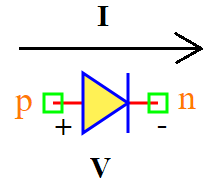Diode Laser
Symbol
Information

A diode laser is a semiconductor device that generates coherent light based on the interaction between electrical current and the active laser medium. It operates similarly to a conventional diode but incorporates additional effects such as thermal resistance and junction capacitance, which influence its behavior.
The current-voltage relationship of the diode laser is given by:
Where:
\(I\) is the current through the diode laser (Amperes)
\(V\) is the voltage across the diode laser (Volts)
\(I_{ss}\) is the saturation current, representing the small leakage current in reverse bias
\(V_t\) is the thermal voltage, depending on temperature
\(n\) is the ideality factor, representing how closely the diode follows the ideal diode equation
\(R_{th}\) is the thermal resistance, modeling heat dissipation
\(C_j\) is the junction capacitance, representing charge storage effects
Diode lasers are widely used in optical communication, laser printing, barcode scanning, and material processing.
Ports
p: Anode (positive terminal)
n: Cathode (negative terminal)
Model
The Diode Laser model implements an advanced nonlinear diode with thermal and capacitance effects.
A diode laser generates light and follows a nonlinear current-voltage relationship while considering thermal and charge storage effects.
Attributes:
V (signal): Input voltage signal across the diode laser, defined between nodes (p, n).
I (signal): Output current signal through the diode laser, defined between nodes (p, n).
Iss (param): Saturation current (default: 1.0e-15 A).
Vt (param): Thermal voltage (default: 0.025 V).
n (param): Ideality factor (default: 1).
Rth (param): Thermal resistance (default: 10 Ω).
Cj (param): Junction capacitance (default: 1e-9 F).
Methods:
analog(): Defines the diode laser behavior using the Shockley equation with thermal and capacitance effects:
from pyams.lib import model, signal, param, voltage, current, explim, ddt
class DiodeLaser(model):
"""
Diode Laser model incorporating thermal resistance and junction capacitance.
"""
def __init__(self, p, n):
# Signal declaration
self.V = signal('in', voltage, p, n)
self.I = signal('out', current, p, n)
# Parameter declaration
self.Iss = param(1.0e-15, 'A', 'Saturation current')
self.Vt = param(0.025, 'V', 'Thermal voltage')
self.n = param(1, ' ', 'The ideality factor')
self.Rth = param(10, 'Ω', 'Thermal resistance between anode and cathode')
self.Cj = param(1e-9, 'F', 'Junction capacitance between anode and cathode')
def analog(self):
"""Defines the diode laser’s current-voltage relationship"""
self.I += self.Iss * (explim(self.V / (self.n * self.Vt)) - 1) + self.Rth * self.V + self.Cj * ddt(self.V)
Command syntax
The syntax for defining a diode laser in a PyAMS simulation:
# Import the model
from pyams.models import DiodeLaser
# DLname: is the name of the diode laser instance
# p, n: The connection points in the circuit
DLname = DiodeLaser(p, n)